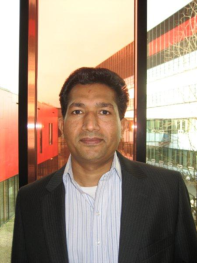Colloidal routes to functional substrates: From selective metallization to superhydrophobicity
Promotion date: 24. February 2012
Promotor: Prof.dr. ir. Bene Poelsema
Assistant promotor: Dr. Stefan Kooij
| Inexpensive colloidal routes were developed to fabricate functional surfaces. Precise patterning of nanoparticles, selective metallization and manufacturing of superhydrophobic surfaces were central themes. A novel colloidal method was explored to achieve highly selective patterning of gold nanoparticles using an amazing interaction of pure water with thoil molecule. Also the fabrication and analysis of films with a variety of surface wettability was part of this study. Substrates with diverse surface roughness were prepared by simple colloidal routes, using silica spheres and gold nanoparticles of different sizes. The effect of surface roughness on surface hydrophobicity was identified. By changing the size of coarser (silica spheres) and finer (gold nanoparticles) structures, films with a variety of wetting properties could be manufactured, ranging from hydrophobic to sticky and non-sticky superhydrophobic. The impact dynamics study of microliter droplets as conducted by high speed photography, revealed impact events including bouncing, partial rebounding, jetting and vibrating sticky balls, depending upon the surface hydrophobicity and surface roughness.
|
Can you mention some special moments?
Some results were very amazing, making the thesis project a successful happening. In the second chapter we described a novel colloidal method where pure water shows the amazing ability to neutralize the binding ability of certain self-assembled monolayers for gold nanoparticles by developing a reversible ‘capping’ layer over thoil molecules. This surprising behaviour of water was used to precisely pattern gold nanoparticles.
Also the study dealing with mono- and multilayer arrays of silica spheres of different sizes treated with PFDTS (1H,1H,2H,2H-perfluorodecyltrichlorosilane), revealed some unthought-of surprises. For example the existence of residual water within the microsphere multilayers during deposition of PFDTS in ambient conditions, appeared to be of prime importance for the formation of siloxane nanostructures thereby resulting the hierarchical roughness. These mechanisms we studied closely and examined them by SEM analyses. We concluded that non-sticky superhydrophobicity could only be achieved on multi-scaled roughness substrates, regardless of the size of the silica spheres.
The preparation of both sticky and non-sticky superhydrophobic surfaces by bottom-up colloidal routes is possible in various inexpensive ways. Hierarchical roughness is manufactured by employing silica sphere arrays as coarser structures, decorated with gold nanoparticles as the finer structures. The role of hierarchy in the roughness determines the superhydrophobic surface to be sticky or just non-sticky as is the case in self-assembled PFOTS (1H,1H,2H,2H-perfluorooctyltriethoxysilane) monolayers.
Did you have some nice publications along the way?
Yes, four publications are online so far, including one about superhydrophobic surfaces by PDFTS nanostructures on silica sphere arrays in Langmuir, one about novel gold nanoparticle pattering using pure water in the Journal of Colloid and Interface Science. At least three publications are still in progress. Also I was a speaker on DFD (Division of Fluid Dynamics of the American Physical Society) conference 2011, USA. As a matter of fact, I won the Mesa+ poster prize at the Mesa+ day in 2008, which, of course, I am very proud of.
Are you a different type of scientist and researcher now?
At first it was challenging to do work in the chemistry lab as I was basically a physicist. Owing to having some experience in the material science lab, along the way I learned to manage the work rather well. Here I quickly developed my experimental skills, getting a good taste of being able to obtain nice results. That indeed was an important discovery for me as a scientist. Another aspect, the Monday morning work discussions in our group, I valued greatly. Here I learned to present my results in a professional manner, also making the best out of the critical remarks of my colleagues which were very encouraging and helped me to direct my work.
Did you feel part of the Mesa+ community?
I can say yes, by participating in Mesa+ colloquies and Mesa+ days I learned a lot as these were great opportunities to hear great scientists on different topics.
What are your future plans?
I plan to go back to my home country and to start my academic research career as assistant professor in the University of Punjab, Lahore, Pakistan. Hopefully I will continue my work on nanostructures and superhydrophobicity. I think important applications can be used in textile industry. The city of Faisalabad, where I originate from, is famous for this industry, being called the Manchester of Pakistan.
Also I would like to transfer knowledge and skills gained here to my students and serve as a guidance to them, using my contacts to make them avail the opportunities to work with some international research groups. In this way, perhaps, I would be able to deliver something back to my home country.

